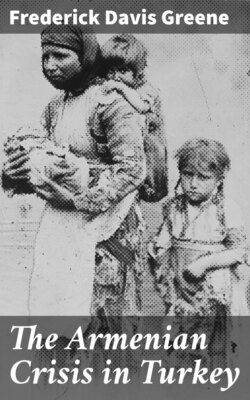Читать книгу The Armenian Crisis in Turkey - Frederick Davis Greene - Страница 18
На сайте Литреса книга снята с продажи.
No. 7.
Оглавление[The following extract is from a personal letter written by one whose name would be immediately recognized by every reader were we at liberty to make public use of it. The writer is a person of broad influence; but for the present, owing to facts which we are not at liberty to relate, he cannot take a public stand. He will probably be heard from yet.]
F..., Nov. 10, 1894.
The massacre which took place a few weeks ago—I do not know the exact date—occurred in the district of Talvoreeg which lies between Moosh and Diarbekir. It is an Armenian district, comprising thirty or forty villages, surrounded by Kourds.
Last year some of the Armenians there armed themselves and resisted the Kourds, who are constantly making raids on their villages and carrying off their property. The Governor sent some soldiers, who killed a few Armenians and received a medal from the government for having wiped out a great rebellion. This year there are said to have been ten or fifteen revolutionists among these Armenians. A Kourdish chief in order to get out of some difficulties that he had gotten into with the government set the ball rolling by carrying off some cattle belonging to certain of the Armenians. The Armenians endeavored to recover the cattle, and a fight followed, in which two Kourds were killed and three were wounded. The Kourds immediately carried their dead to Moosh, laid them down at the government house, reporting that Armenian soldiers were overrunning the land, killing and plundering them.
This furnished the government with the desired excuse for collecting soldiers from far and near. The general is said to have worn on his breast an order from Constantinople, which he read to the soldiers, commanding them to cut down the Armenians root and branch, and adjuring them if they loved their Sultan and their government they would do so. A terrible massacre followed. Between five and ten thousand Christians are said to have been butchered in a most terrible manner. Some soldiers say a hundred fell to each one of them to dispose of; others wept because the Kourds did more execution than they.
No respect was shown to age or sex. Men, women, and infants were treated alike, except that the women were subjected to greater outrage before they were slaughtered. The women were not even granted the privilege of a life of slavery. For example, in one place three or four hundred women, after being forced to serve the vile purposes of a merciless soldiery, were taken to a valley near by and hacked to pieces with sword and bayonet. In another place about two hundred women, weeping and wailing, knelt before the commander and begged for mercy, but the blood-thirsty wretch, after ordering their violation directed the soldiers to dispatch them in a similar manner. In another place a large company, headed by the priest, fell down before the officers saying they had nothing to do with the culprits, and pleading for compassion, but all to no purpose—all were killed. Some sixty young brides and more attractive girls were crowded into a little church in another village, where, after being violated, they were slaughtered, and a stream of human blood flowed from the church door. To some of the more attractive women in one place the proposition was made that they might be spared if they denied their faith. “Why should we deny Christ,” they said, and pointing to the dead bodies of their husbands and brothers before them, they nobly answered, “We are no better than they; kill us too,”—and they died.
After the above-mentioned events the Governor attempted to persuade and compel the Armenians to sign a paper thanking the Sultan and himself that justice had been done to the rebels!
